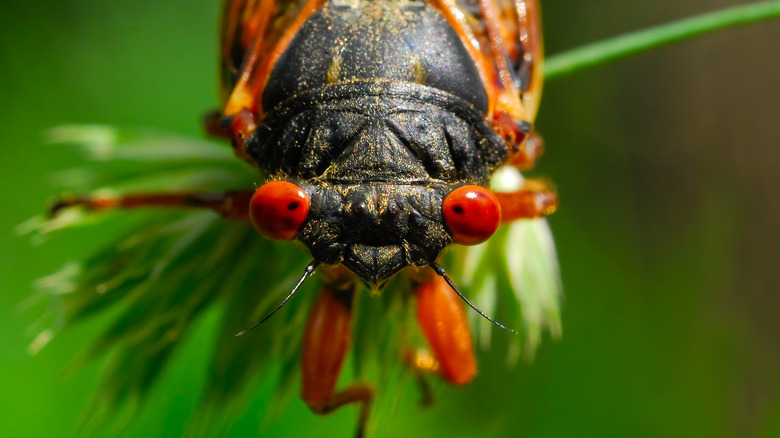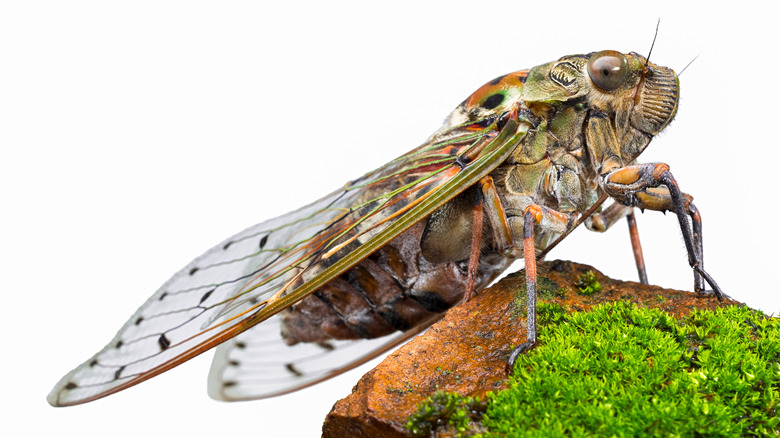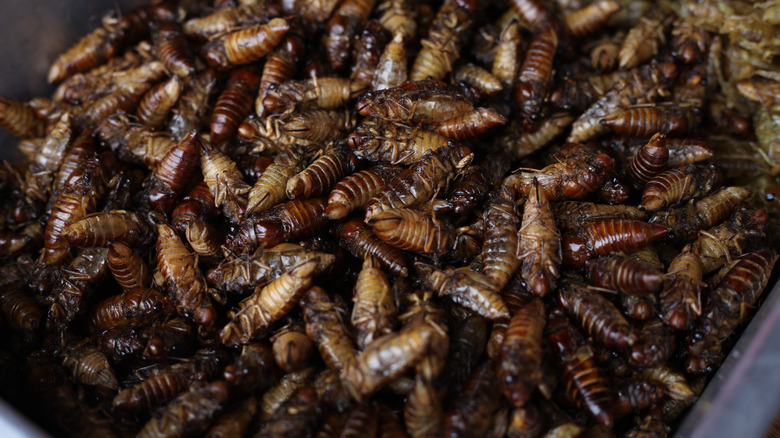The Psychedelic Fungus That's Infecting Cicadas
Life is hard enough, isn't it? Getting up every morning and having to deal with all the other beings on this planet, it's enough to make someone turn over and pull the covers way over their head. Which, unfortunately, is not an option for the good ol' cicada. With their emergence after 17 years of eating and sleep underground, the insects known as the Brood X cicada, (via CNN) have already begun infiltrating southern states like Tennessee and Georgia. With their overwhelming numbers, general noisiness, and havoc they create, the rest of the Midwest can expect an earful assault in the coming weeks as more cicadas begin to emerge from the ground.
According to the National Wildlife Federation, periodical cicadas (cicadas that emerge from the ground on a cyclical basis) are part of the insect world known as Hemiptera (which include aphids like ladybugs and leafhoppers like grasshoppers). Measuring over an inch long with a three-inch wing span, cicadas begin their lives as eggs birthed in trees, low to the ground. After hatching, the larva spend the balance of their lives, feeding and living underground. Depending on the species of cicada (whether annual or periodical), a brood of the insects emerge from the ground after a set period (most cicadas fall into species that emerge from the ground after 13 or 17 years) to begin the whole cycle again.
A psychedelic fungus that easily spreads
The cicadas that have been in the news the last couple of weeks are known as Brood X. A type of cicada with a 17-year gestation period, the Brood X have begun emerging from the ground across the Midwest. As soil temperatures in the United States reach 64 degrees Fahrenheit, more and more cicadas will emerge. Interestingly enough, scientist have discovered a fungus that, when ingested by the emerging cicada, turns them into sex-crazed zombies (via NPR).
Known as Massospora, scientists believe that spores from the fungus infect the cicada larva as it emerges from the ground. Once the bugs emerge from the ground, they shed their skin and become adult cicadas. However, those cicadas infected with the Massospora spores, have their lower abdomens fall off with their shedding skin. By losing their lower abdomens, the cicadas are effectively losing their sex organs. According to Smithsonian Magazine, what replaces the lower abdomen of the infected insect is a white fungus. The fungus sticks out further than the bug's original abdomen, making it easier for the fungus to spread to other insects.
Attack of the sex-crazed zombies
The really fascinating part of the fungus is that it puts the cicada into a "sexually frenzied" state. According to The Guardian, Massospora contains the same chemical (known as cathinone) that makes certain mushrooms psychedelic. An amphetamine, cathinone rewires the brains of infected cicadas, increasing their sex drives, thereby making the insect a sex-crazed zombie. The fungus then attracts other cicadas to the infected one. However, since the fungus made the infected cicada lose its lower abdomen, the only "funny business" going on is another cicada being infected by the spores.
Interestingly enough, The Guardian also states that it's not uncommon for people who happen to eat infected cicadas to have psychedelic experiences. Cathinone in the infected cicadas can cause some mind-altering experiences. However, Matt Kasson, associate professor of forest pathology and mycology at West Virginia University, suggests NOT eating these psychedelic bugs. "There's always a risk in eating cicadas pump-filled with amphetamines. That was just one of a thousand compounds we found in the cicadas, and we don't know what those other compounds are capable of doing to humans."
Moral of the story? It's probably best to stick with plants when planning your next psychedelic trip. You just never know what you're gonna get chowing down on infected cicadas.


